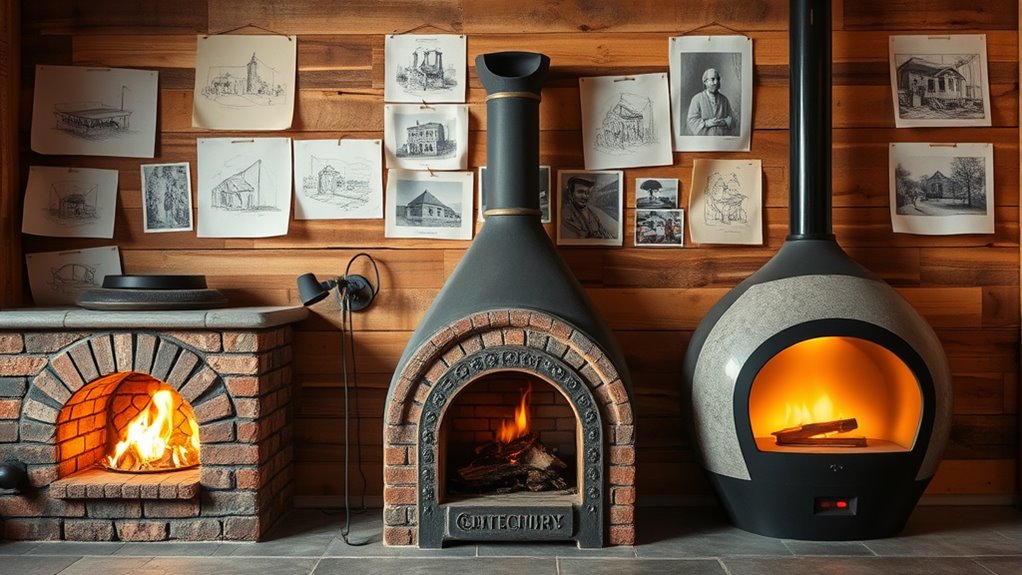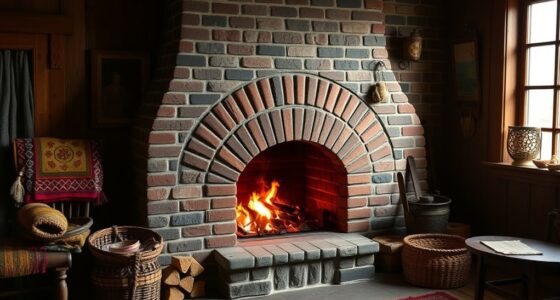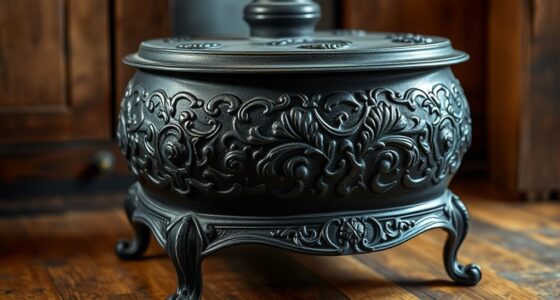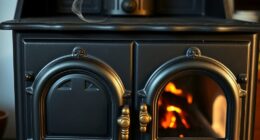Masonry heaters have evolved from simple stone and brick fires used by early civilizations, which absorbed heat during the day and released it slowly at night. In medieval times, large, thick-walled stoves became common across Europe, helping homes stay warm longer. With industrial advancements, designs improved through new materials and engineering, making them more efficient and eco-friendly today. If you explore further, you’ll discover the impressive innovations behind these timeless heating systems.
Key Takeaways
- Early civilizations used simple stone and brick fires to absorb and gradually release heat, laying the foundation for masonry heaters.
- Medieval European homes featured large masonry stoves with thick walls designed to store heat and extend warmth.
- Innovations included integrating fire chambers, flues, and heat exchangers to improve heat retention and distribution.
- The Industrial Revolution introduced new materials and manufacturing techniques, enhancing efficiency and accessibility of masonry heaters.
- Modern masonry heaters combine traditional craftsmanship with engineering advances, offering long-lasting, energy-efficient heating solutions.
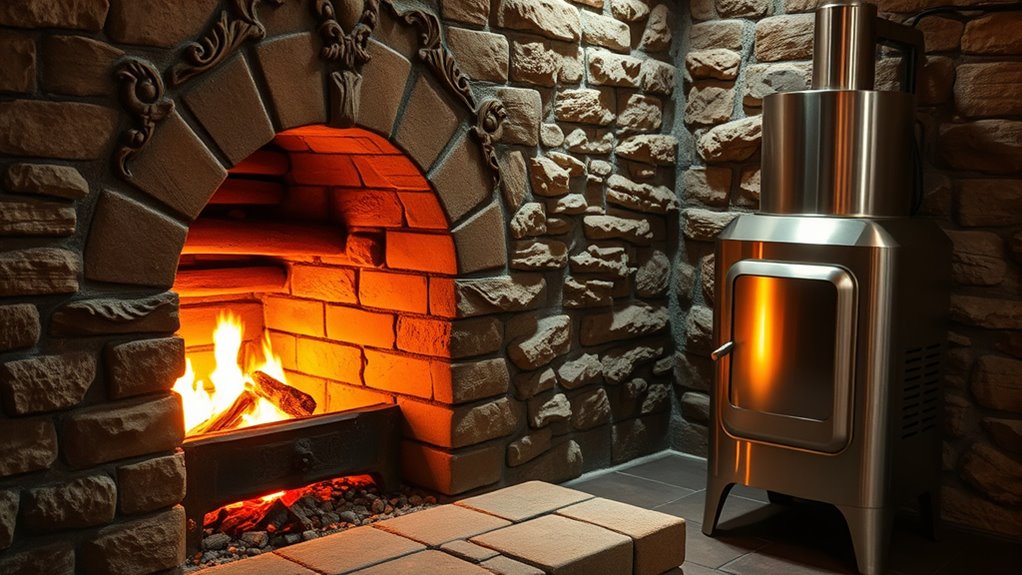
Have you ever wondered how some homes stay warm with less energy? The secret often lies in the design and materials of the heating system, especially when it comes to masonry heaters. These heaters utilize thermal mass to store and radiate heat efficiently, making them a sustainable choice for keeping your space cozy. To understand their power, it helps to look at the historical evolution of masonry heaters. Over centuries, people have developed and refined these systems, starting from simple hearths to complex, highly efficient structures. Initially, early civilizations used basic stone and brick fires that absorbed heat during the day and released it slowly at night. As building techniques advanced, so did the understanding of how thermal mass worked, leading to more sophisticated designs that could retain heat longer. During the Middle Ages, large masonry stoves became common in European homes, especially in colder climates. These devices were built with thick walls of stone or brick, designed to absorb the heat from a single fire and radiate it gradually over several hours. Their ability to store thermal energy was a game-changer, allowing homes to stay warm longer without constant fires. Over time, the design of masonry heaters became more refined, integrating features like fire chambers, flues, and heat exchangers to maximize the use of thermal mass. The industrial revolution brought new materials and manufacturing techniques, making these heaters more efficient and accessible. Today, modern masonry heaters combine traditional principles with contemporary engineering, emphasizing sustainability and energy efficiency. They are designed to absorb heat quickly from a fire, then release it slowly over many hours, reducing fuel consumption and emissions. Their success hinges on understanding and leveraging thermal mass — the capacity of heavy, dense materials to store heat. When you use a masonry heater, you’re benefiting from centuries of innovation, where each generation improved on the last by better understanding how to harness heat. The evolution from simple stone hearths to highly efficient, self-contained heating systems illustrates how technological advances and a deep understanding of thermal mass have shaped this craft. This historical journey shows that masonry heaters are more than just functional; they are a testament to human ingenuity, combining traditional craftsmanship with modern sustainability goals. So, the next time you see a masonry heater, remember it’s not just a heating device—it’s a piece of history, a carefully crafted system built on centuries of innovation that continues to adapt to our needs. It’s a perfect example of how understanding thermal mass can lead to smarter, more efficient ways to keep warm, blending the old with the new in a timeless dance of heat and human ingenuity.
Frequently Asked Questions
How Do Masonry Heaters Compare to Modern Central Heating Systems?
Masonry heaters are more cost-efficient and environmentally friendly than modern central heating systems. They heat your space using wood, which is renewable, producing less pollution. Their design stores heat for hours, reducing energy consumption and ongoing costs. Unlike central systems that rely on electricity or fossil fuels, masonry heaters offer a sustainable, efficient way to stay warm, helping you save money and lessen your environmental impact over time.
What Historical Civilizations First Used Masonry Heating Techniques?
Think of ancient civilizations like the Romans and Chinese as the pioneers of masonry heating. The Ancient Romans built elaborate hypocaust systems that warmed villas, while Chinese innovations included intricate brick and tile heaters used in palaces. You can see how these early techniques laid the groundwork for modern masonry heaters, blending artistry with function to heat spaces efficiently. Their ingenuity echoes through centuries, inspiring today’s sustainable heating solutions.
Are Masonry Heaters Energy-Efficient by Today’s Standards?
Masonry heaters are highly energy-efficient by today’s standards because they use thermal insulation to retain and slowly release heat, reducing fuel consumption. They also meet modern emission standards by burning wood more completely, resulting in cleaner emissions. If you install a masonry heater, you’ll benefit from consistent warmth and lower energy costs, making it an eco-friendly and cost-effective heating option that aligns with current efficiency and environmental requirements.
Can Masonry Heaters Be Integrated Into Contemporary Home Designs?
Yes, you can integrate masonry heaters into contemporary home designs. Focus on design integration by choosing sleek, minimalist styles that blend seamlessly with modern aesthetics. You can also enhance aesthetic compatibility by selecting materials and finishes that complement your decor. Skilled installers will help you customize the heater’s appearance, ensuring it remains both functional and visually appealing, making it a stylish and energy-efficient addition to your home.
What Maintenance Is Required to Keep a Masonry Heater Functioning Properly?
You should clean your chimney regularly, at least once a year, to prevent creosote buildup, which causes about 30% of chimney fires. To keep your masonry heater functioning properly, remove ash after each burn to maintain airflow and efficiency. Also, schedule annual chimney cleaning to ensure safe operation. Regular maintenance like this helps your heater run smoothly, saving you money and reducing fire hazards.
Conclusion
Throughout history, masonry heaters have evolved from simple, functional structures to sophisticated works of art. While ancient models relied on basic fire and stone, modern designs incorporate advanced technology and craftsmanship. Yet, despite these advancements, their timeless appeal remains rooted in the warmth and comfort they provide. Like a bridge between the past and the present, masonry heaters connect you to centuries of tradition—proving that some innovations, no matter how modern, stay true to their enduring purpose.

